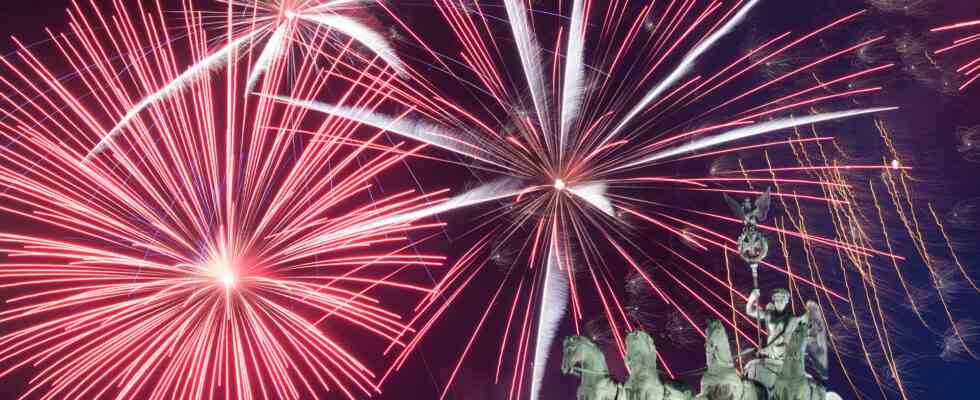FAQ
Status: 12/30/2022 5:44 am
They glow green, red, or gold, explode with a loud bang, or burn up in tinsel-like streaks. But what exactly is in firecrackers and rockets? And why are illegal crackers so dangerous?
Why are the rockets taking off?
Inside the rocket is black powder, which is a mixture of a fuel, such as charcoal and sulfur, and an oxidizer, such as potassium nitrate, that accelerates combustion. When the fuse sets it on fire, the reaction produces heat and gases such as nitrogen or CO2.
The design of the rocket is then responsible for the flight: the gases can only escape through the hole on the back that the fuse has burned in – this pushes it forward and lifts off. The long wooden stick ensures that it rises straight into the sky and does not start to spin. That’s why experts warn against igniting rockets with broken wooden sticks, because they can fly around uncontrolled and injure people.
And what about firecrackers?
Here, too, black powder plays the decisive role – and the structure of the firecracker: If you ignited the black powder in the open, it would simply burn down. But because it is wrapped very tightly in paper in the firecracker and there is no outlet, high pressure is created and the gases produced during the reaction explosively pave their way. The result: A small flash of light, a loud bang and a torn shell. The more gunpowder you use, the bigger the explosion. However, the absolute amounts are very small: only around two grams of black powder are used even for a large D-Böller.
What makes the different colors?
The rocket usually consists of two chambers: when the fuel in the first chamber is exhausted, the second chamber ignites with an explosive mixture, also known as effect chemicals. In addition to black powder, it contains various salts – they ensure the colorful spectacle in the sky.
With magnesium, for example, you get whitish flash effects, for red sparks you need substances like strontium or calcium and copper compounds glow green. There are numerous other salts, each painting its own color in the sky, from crimson to azure to emerald green. They all burn at temperatures of around 1000 degrees – that’s why a misguided rocket can also cause such serious injuries.
The chemicals are usually applied to a carrier, explains Christian Schragen from fireworks manufacturer WECO. This is usually rapeseed, oats or rice – so we shoot up a whole lot of grain on New Year’s Eve.
How are the different shapes created?
Stripes of light in the sky, long flickering or the famous shower of gold: In addition to the substances used, it is above all the design of a rocket that determines what the explosion looks like. The effect chemicals are often arranged in a circle around the explosive device: This creates, for example, large, round explosion images – pyrotechnicians speak of bouquets – in the sky.
Other forms such as the laburnum can be created, for example, by means of cylindrical explosion chambers. A flickering followed by dozens of explosions can be caused by the fact that different powder mixtures are layered on top of each other on the rapeseed grains. “There are reactions that lead to a rather dark burn and there are reactions that produce light. Strobe sets are designed so that both happen alternately,” says Schragen.
Why are illegal firecrackers so dangerous?
Doctors and other experts warn: Illegal firecrackers are an enormous health risk. On the one hand, this is because they can be significantly stronger than is permitted in Germany. In addition, no one knows exactly what is in it. That Federal Office for Materials Science warns they “often not only contain gunpowder, but are filled with a much more responsive flash-bang composition”.
Another risk is the fuse: If it burns off too quickly, for example because inferior or unsuitable material is used, the firecracker can explode in your hand – and cause serious injuries. That’s why you should pay attention to safety features such as the CE mark when buying fireworks.
And what about fine dust?
According to the Federal Environment Agency (UBA), more than 2000 tons of fine dust are released by fireworks every year, the majority on New Year’s Eve. “This amount corresponds to about one percent of the total amount of fine dust released in Germany,” it says UBA. In many places, especially large cities, existing limit values are exceeded many times over – sometimes by a factor of 20, like the one Federal Association of Pneumologists (BdP) explained. How quickly the fine dust pollution drops afterwards depends primarily on the weather. In the worst case, the pollution can last for days.
Particulate matter is associated with many diseases and, according to the EU, is responsible for an estimated 240,000 premature deaths in the member states. The BdP warns “that patients with asthma and other chronic respiratory diseases in particular can also suffer from short-term massive air pollution”.

